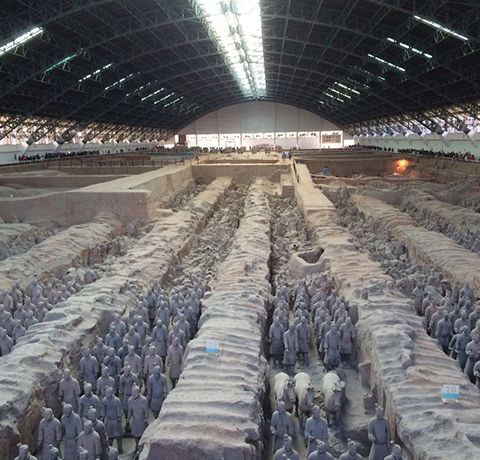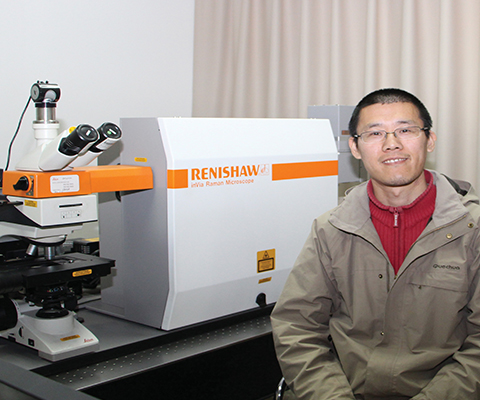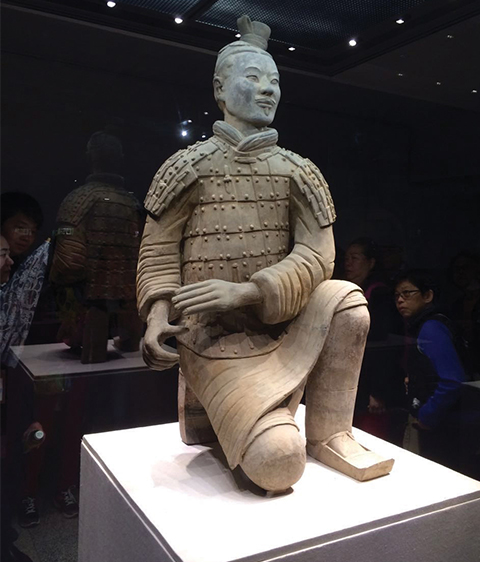Renishaw's inVia used to study the Terracotta Warriors and Horses of the Qin Dynasty
Known as the ‘Eighth Wonder of the World', the Terracotta Warriors and Horses site was discovered in 1974. It consists of three figure pits covering an area over 20,000 square metres and forms part of Emperor Qin Shihuang's Mausoleum Site Museum, the largest imperial tomb in China.
The pits contain approximately 8,000 terracotta warriors and horses, as well as over 100 chariots. In 1987 they were included in the ‘World Heritage List' by UNESCO.
The sculptures are located in Lintong District, Xi'an, Shaanxi Province, China, which sits 1 km to the east of Emperor Qin Shihuang's mausoleum. Each life-sized figure is unique, with intricate details, including individual facial expressions and costumes. Originally the terracotta warriors were painted in bright pigments but, over 2000 years, the colours have faded and only small traces of pigment can be found on their faces, hands, costumes and shoes.
The conservation, study and analysis of these precious ancient cultural relics is incredibly complex. Dr. Yin Xia, the Deputy Director of the Relics Conservation and Restoration Department at the Emperor Qin Shihuang's Mausoleum Site Museum, has used Raman microscopy to study historical relics since 2006. In 2008, the museum purchased a Renishaw inVia confocal Raman microscope to help identify pigments on the terracotta figures, as well as determining key information required for their conservation and restoration.

In addition to his work with Emperor Qin Shihuang's Mausoleum Site Museum, Dr. Xia is the Deputy Director of the Key Ceramic Painted Cultural Relics Research Site, under the State Administration of Cultural Heritage, as well as a part-time tutor of North-West University, China. At the university, his research mainly focuses on the analysis and identification of painted relics.
Dr. Xia started his analysis of the ancient pigments of cultural relics in 2003 and has made a number of landmark discoveries. For example, under the polarizing microscope, Chinese Blue (BaCuSi4O10), Chinese Purple (BaCuSi2O6) and dark blue particles of a new pigment (BaCu2Si2O7) often co-exist in a sample. As they appear in minute amounts—sometimes there are only one or two particles—it is hard to separate them individually with regular analytical means. Dr. Xia first discovered the new dark blue pigment with the inVia Raman microscope1.
Dr. Xia has participated in a number of conservation programmes on the historical relics of Emperor Qin Shihuang's mausoleum and Qin terracotta figures. Since 2004, he has been focusing his research on painted terracotta figures and pigments on historical relics. He has completed the analysis of murals and painted relics at nearly one thousand sites distributed in 14 provinces and autonomous regions in China.

Dr. Xia and his team have also analysed the composition of coloured pigments on ceramics unearthed from West Han Dynasty tombs in Weishan, Shandong province, and discovered Chinese Purple on these cultural relics for the first time. The pigment of Chinese Purple was rarely used on ancient coloured painted artefacts. In the past, it has been found in only a few provinces such as Gansu, Shaanxi, Henan and Jiangsu. The discovery of this pigment in relics within Shandong province has expanded the geographical area in which it was used, which has important archaeological significance2.
Many different scientific techniques can be used to study historical relics, including: elemental analysis, using X-ray fluorescence spectroscopy (XRF); laser induced breakdown spectroscopy (LIBS); chemical and structural analysis methods, such as laser Raman spectrometry; X-ray diffraction (XRD); and morphological analysis, with powder polarizing microscopes (PLM) and scanning electron microscopes (SEM).

Each method has its pros and cons. For example, XRF is a mature elemental analytical technology but cannot be used for chemical structure analysis; XRD is widely used for the qualitative analysis of cultural relic materials but requires large amounts of sample; PLM can analyse samples by crystal morphology, colours and impurities of particles, but cannot identify the structure of samples. All these analytical methods are essential but, given the precious and delicate nature of historical relics, non-destructive testing and analysis has become increasingly important in recent years.
Raman spectroscopy is non-contacting and non-destructive, making it perfect for the analysis of historical relics. It provides information about origin, age and authenticity, while preserving the entire sample. It also has the flexibility to take measurements in situ, so there is no need to remove fragments for analysis.
According to Dr. Xia, tiny particles left on the gloves of the museum staff after they have moved the terracotta figures are collected for Raman analysis. These samples can be analysed repeatedly using Raman spectroscopy, without damage, enabling subsequent analysis with other techniques, such as electron microscope analysis.
Before using a Raman Microscope, a polarizing microscope was a major tool in Dr. Xia's laboratory. When being asked why he chose a Raman Microscope Dr. Xia said, “We are unable to determine the molecular structure of a sample with the polarizing microscope. For example, if we observe atacamite under a polarizing microscope, we cannot distinguish it from its isomers such as botallackite and paratacamite, but with a Raman microscope, we can get the results immediately.”
The inVia Raman microscope was chosen by Emperor Qin Shihuang's Mausoleum Site Museum for its extreme flexibility. “The Renishaw inVia Raman microscope and spectrometer are discrete, so I can configure what I want on the microscope without affecting the whole system.” Dr. Xia said, “Products from other vendors adopt embedded or integral microscope designs, which do not meet our requirements.”
Understanding coloured pigments is important for scientific archaeology and cultural relic conservation. It can provide valuable information for exploring the evolution of ancient pigment technology, which helps with the development of relevant conservation programs. Furthermore, research on the structure and composition of ancient coloured pigments has become an important basis for determining the age and the origin of raw materials, as well as conservation and restoration programs for cultural relics. “We are using Raman microscopy for coloured painting analysis in this intense area of detailed research” Dr. Xia commented.
For more information about Renishaw's inVia confocal Raman microscope, visit: www.renishaw.com/invia
This case study is edited based on the article “Exploring the potential of Raman spectroscopy for historical relic studies - Interview with Dr. Yin Xia, the Deputy Director of Emperor Qin Shihuang's Mausoleum Museum” released 2 May, 2015 on www.instrument.com.cn Author: Ye Jian.
References
1. Development of Chinese barium copper silicate pigments during the Qin Empire based on Raman and polarized light microscopy studies. Journal of Archaeological Science 49 (2014) 500-509
2. Xia Yin, Wu Shuang Cheng, Cui Sheng Yuan, et al. Study on Coloured Pigments on Ancient Ceramics Unearthed from West Han Dynasty Tombs in Weishan, Shandong Province. Sciences of Heritage Conservation and Archaeology, 2008, 20 (2): 13-18